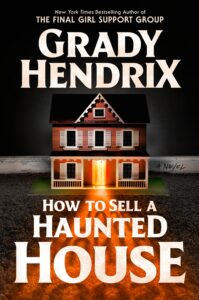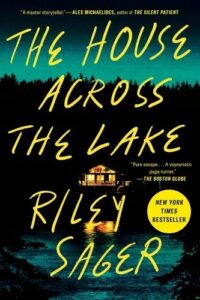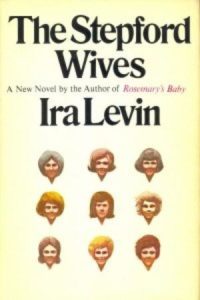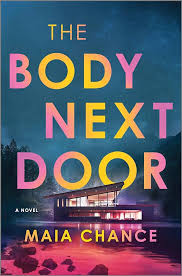I adore a good domestic thriller. Instead of going big, domestic thrillers go deep, mining the ordinary world of home and family for its terrible secrets. And there’s always this moment when a character wonders about their spouse or parent or child, Wait, do I really know this person AT ALL? It’s a trapdoor flopping open under our sacred ideas of the perfect marriage, the perfect home, the perfect life. What comes next in the story is existential freefall.
It feels so natural for domestic thrillers to spin even farther out into that freefall by introducing uncanny elements like demonic possession, ghosts, astral projection, robots, and magic. These aren’t mere gimmicks, either. Freud famously investigated the concept of unheimlich, the German word for uncanny that can be directly translated as unhomelike. He writes that the uncanny is about intellectual uncertainty regarding the unfamiliar, but it also “applies to everything that was intended to remain secret, hidden away, and has come into the open.” (Doesn’t that sound like every domestic thriller you’ve ever read?) In short, the uncanny isn’t simply strange; it’s the familiar, the homelike, turned upside-down and inside-out.
Pairing domestic tumult with supernatural intrigue isn’t anything new, of course. Gothic fiction from the eighteenth and nineteenth centuries is built of haunted homes and lurid family relations. Take, for instance, Poe’s 1840 story “The Fall of the House of Usher,” in which siblings Roderick and Madeline share a diseased symbiotic relationship with their dilapidated mansion. The fascinating house. The whacko family. That weird glow coming from the swamp outside. It’s no wonder that almost two hundred years later we’re still retelling this story. What’s newer are stories about uncanny domesticity with faster-paced, thriller-shaped plots. This to me is the recipe for a book designed for devouring. For instance:

Rosemary’s Baby by Ira Levin
Speaking of devouring: in Levin’s Rosemary’s Baby, the young wife Rosemary develops a taste for raw meat after she becomes pregnant—possibly with demon spawn. Levin’s cool, clean style and natural dialogue seduces us into thinking all of this is perfectly plausible, and that’s the point: the power of this novel is in its sense of everyday reality gone sickeningly wrong.

How to Sell a Haunted House by Grady Hendrix
While Grady Hendrix’s How to Sell a Haunted House is usually shelved as horror, I’m calling it a domestic thriller, too. That’s because the central relationship at play is between an adult brother and sister, Louise and Mark, who are tasked with getting their deceased parents’ hoarder-situation ranch house on the market. Unfortunately for them, the house is haunted, first by creepy dolls and then by one of the scariest monsters I have ever encountered on the page: Pupkin the puppet. I’m queasy just thinking about his sock puppet writhing. What really elevates this story is how the demonic puppet functions as a metaphor for generational trauma without ever being too on the nose.

Behind Her Eyes by Sarah Pinborough.
Behind Her Eyes starts off with a Bridget Jones-like scenario—boozy single mom Louise, a stolen kiss with David who turns out to be her new boss, a voyeuristic obsession with David’s seemingly perfect marriage—only to arrive at a gasp-eliciting twist. When David looks at his wife and wonders, Who the heck ARE you?, Behind Her Eyes has the most uncanny answer.

The House Across the Lake by Riley Sager
Sager’s The House Across the Lake also engages the voyeuristic set-up of the drunk woman who’s just a little too interested in the apparently perfect lives of her neighbors. When she enters their orbit by rescuing the wife from drowning, things take a turn. And then another turn. And another. And another. The series of twists in this book isn’t for the fainthearted, but I enjoyed how Sager dares to go all the way.

The Stepford Wives by Ira Levin
As in Rosemary’s Baby, Levin’s minimalist writing is the creepiest thing about the whole story. The words on the page are as crisp as a white picket fence, so it takes a while to fully acknowledge the dread sneaking up from behind. The town of Stepford is domestic perfection (again, that thing we’re all just dying to knock down), and just FYI, a smiling lady robot is the featured image on the Wikipedia entry for Uncanny.

Made for You by Jenna Satterthwaite
Satterthwaite updates the Stepford tradition for the AI age with Made for You, a page-turning thriller about a Julia—a Synth, or synthetic human woman—who wins a Bachelor-style reality TV competition. What’s supposed to follow is the perfect domestic life with the husband for whom Julia was manufactured, but things go sideways when the husband disappears.
Ironically, Julia is a Synth yet she’s immensely sympathetic. It’s her human husband who is ultimately unknowable.
The Body Next Door by Maia Chance
My own uncanny domestic thriller, The Body Next Door, is about an extended family that harbors a supernatural secret. The protagonist Hannah’s domestic life may not be perfect, but it looks perfect. But everything changes when a body is dug up in the wooded lot next door to her weekend house on a remote island in the Pacific Northwest. When Hannah catches her husband Allan in a lie, she embarks on a quest to find out what he’s hiding—and what she’s been hiding from herself about her own past. As Hannah races to unmask the killer, she’s also pushed to redefine for herself what “the perfect life” looks like, and she ultimately discovers that she can find her way out of the woods—literally and metaphorically—but only if she remembers how to believe in magic.
***
I love how magic, ghosts, robots, and demons inject domestic thrillers with fresh imagination. I especially love how uncanny elements open up new ways to write about marriage, family, and home. I mean, any domestic thriller can explore the idea that, say, a baby or a mother-in-law is monstrous, but why not go there and make the baby or the mother-in-law an actual monster?


















